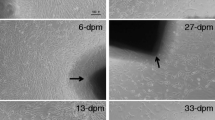Abstract
Caspian horse, a rare horse breed found in 1965 by Louise Firouz in northern Iran, is a small horse which is reported to be in danger of extinction in its original homeland. There seems to be a great need to prevent extinction of this valuable horse. In this study, 51 fibroblast cell lines from Caspian horse ear marginal tissue were successfully established by sampling 60 horses using primary explant technique. Cells were authenticated and growth curve was plotted. According to results obtained, population doubling time (PDT) was calculated 23 ± 0.5 h for all cell lines. Multiplex polymerase chain reaction (multiplex PCR) revealed that cell lines had no cross-contamination with other species. Bacteria, fungi, and mycoplasma contamination were checked using standard methods such as PCR, direct culture, and Hoechst staining. In addition to providing a valuable source for genomic, postgenomic, and somatic cloning researches, the established cell lines would preserve Caspian horse genetic resources. It will also create an accessible database for researchers.






Similar content being viewed by others
References
Amirinia C, Seyedabadi H, Banabazi MH, Kamali MA (2007) Bottleneck study and genetic structure of Iranian Caspian horse population using microsatellites. Pak J Biol Sci 10(9):1540–1543
Cooper JK, Sykes G, King S, Cottrill K, Ivanova NV, Hanner R, Ikonomi P (2007) Species identification in cell culture: a two-pronged molecular approach. In Vitro Cell Dev Biol Anim 43(10):344–351
Easley CA 4th, Phillips BT, MM MG, Barringer JM, Valli H, Hermann BP, Simerly CR, Rajkovic A, Miki T, Orwig KE, Schatten GP (2012) Direct differentiation of human pluripotent stem cells into haploid spermatogenic cells. Cell Rep 2(3):440–446
Escriou V, Carrière M, Bussone F, Wils P, Scherman D (2001) Critical assessment of the nuclear import of plasmid during cationic lipid-mediated gene transfer. The journal of gene medicine 3(2):179–187
Freshney RI (2010). Culture of animal cells: a manual of basic technique and specialized applications., Wiley-Blackwell.
Gibons J, Gamange S, Hanotte O, Iñiguez L, Maillard JC, Rischkowsky B, Semanbo D and Toll J (2006). Options and Strategies for the Conservation of Farm Animal Genetic Resources. Report of an International Workshop (7–10 November 2005, Montpellier, France). Rome, Italy, CGIAR System-wide Genetic Ressources Programme (SGRP): 53.
Groeneveld E (2007) A world wide emergency programme for the creation of national genebanks of endangered breeds in animal agriculture. Stočarstvo 61(6):427–434
Gu Y, Li H, Miki J, Kim KH, Furusato B, Sesterhenn IA, Chu WS, McLeod DG, Srivastava S, Ewing CM, Isaacs WB, Rhim JS (2006) Phenotypic characterization of telomerase-immortalized primary non-malignant and malignant tumor-derived human prostate epithelial cell lines. Exp Cell Res 312(6):831–843
Gupta N, Gupta SC, Ahlawat SPS, Sharma R, Gupta K and Taneja R (2005). Applications of Gene-Based Technologies for Improving Animal Production and Health in Developing Countries, Springer Netherlands.
Hatami Monazah H, Pandit RV (1979) A cytogenetic study of the Caspian pony. J Reprod Fertil 57(2):331–333
Hinrichs K (2006) A review of cloning in the horse. Reproduction 52:398–401
Klingbeil MF, Herson MR, Cristo EB, dos Santos Pinto D Jr, Yoshito D, Mathor MB (2009) Comparison of two cellular harvesting methods for primary human oral culture of keratinocytes. Cell Tissue Bank 10(3):197–204
Kong D, Nishino N, Shibusawa M, Kusano M (2007) Establishment and characterization of human pancreatic adenocarcinoma cell line in tissue culture and the nude mouse. Tissue Cell 39:217–223
Lima-Neto JF, Fernandes CB, Alvarenga MA, Golim MA, Landim-Alvarenga FC (2010) Viability and cell cycle analysis of equine fibroblasts cultured in vitro. Cell Tissue Bank 11:261–268
Moore CM and Best RG (2001). “Chromosome Preparation and Banding.” eLS.
Petersen JL, Mickelson JR, Cothran EG, Andersson LS, Axelsson J et al (2013) Genetic diversity in the modern horse illustrated from genome-wide SNP data. PLoS One 8(1)
Recillas-Targa F (2006) Multiple strategies for gene transfer, expression, knockdown, and chromatin influence in mammalian cell lines and transgenic animals. Mol Biotechnol 34(3):337–354
Richer CL, Power MM, Klunder LR, McFeely RA, Kent MG (1990) Standard karyotype of the domestic horse (Equus caballus). Hereditas 112:289–293
Rui R, Qiu Y, Hu Y, Fan B (2006) Establishment of porcine transgenic embryonic germ cell lines expressing enhanced green fluorescent protein. Theriogenology 65(4):713–720
Ruvinsky A and Bowling AT (2000). The Genetics of the Horse, CABI.
Song J, Hua S, Song K, Zhang Y (2007) Culture, characteristics and chromosome complement of Siberian tiger fibroblasts for nuclear transfer. In Vitro Cell Dev Biol Anim 43(7):203–209
Takashima A (2001) Establishment of fibroblast cultures. Curr Protoc Cell Biol. doi:10.1002/0471143030.cb0201s00
Volokhov DV, Graham LJ, Brorson KA, Chizhikov VE (2011) Mycoplasma testing of cell substrates and biologics: review of alternative non-microbiological techniques. Mol Cell Probes 25(2–3):69–77
Woods GL, White KL, Vanderwall DK, Li GP, Aston KI, Bunch TD, Meerdo LN, Pate BJ (2003) A mule cloned from fetal cells by nuclear transfer. Science 301(1063)
Woolliams J, Wilmut I (1999) New advances in cloning and their potential impact on genetic variation in livestock. Anim Sci 68:245–256
Wright S (1969). Evolution and the Genetics of Populations. Chicago, University of Chicago Press.
Yee J (2010) Turning somatic cells into pluripotent stem cells. Nature Education 3(9):25
Acknowledgments
The authors express their gratitude to Mirian, Afshar, Khojir and Guilan research complex staff, and Vaezi (private horse owner) for sample supply. We are also grateful to the Human and Animal cells bank staff for their contribution to this research. This research was supported by the Iranian Biological Resources Center (IBRC).
Author information
Authors and Affiliations
Corresponding author
Ethics declarations
Conflict of interest
The authors declare that they have no conflict of interest.
Additional information
Editor: Tetsuji Okamoto
Rights and permissions
About this article
Cite this article
Daneshvar Amoli, A., Mohebali, N., Farzaneh, P. et al. Establishment and characterization of Caspian horse fibroblast cell bank in Iran. In Vitro Cell.Dev.Biol.-Animal 53, 337–343 (2017). https://doi.org/10.1007/s11626-016-0120-3
Received:
Accepted:
Published:
Issue Date:
DOI: https://doi.org/10.1007/s11626-016-0120-3




